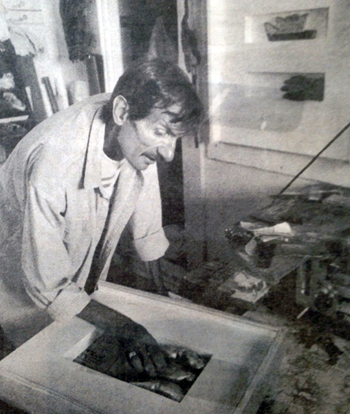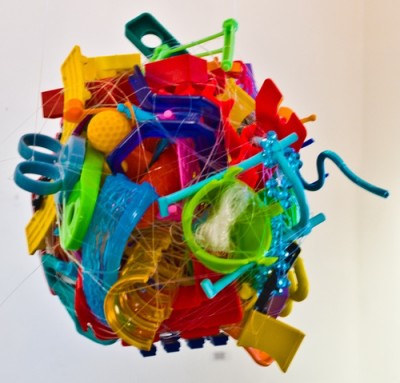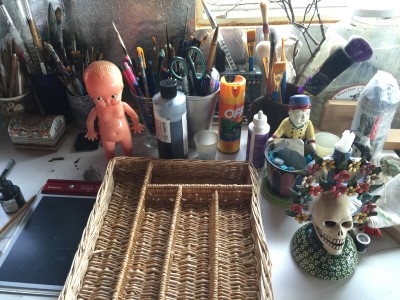
The Thing You Need is Often Nearby
“The thing you need is often nearby.” – James Joyce
“A rock pile ceases to be a rock pile the moment a single man contemplates it, bearing within him the image of a cathedral.” -Antoine de Saint-Exupery
Before he died too young, Provincetown artist Ray Keyton constructed shadow boxes. Precisely conceived, their harmony, their mystery, their cohesion, stayed with you.
His medium was objects he’d collect for their potential. He was attracted to the planes, curves, hues, textures, age of things.
He had accumulated a lot of stuff. Like a poet choosing words Keyton bound certain objects into improbable relationships, aiming for emotionally evocative assemblages larger than the sum of their parts.
In one Keyton series a single component linked the boxes together, becoming for him a form of signature.
By a stroke of luck a collection of hundreds of taxidermied songbirds, each morgue-ishly bearing a hand-written paper ID tag, had come into Keyton’s possession. The little birds became the keystone of Keyton’s compositions, charging each piece with their eerie, mute, almost-alive dignity.
The thing you need is often nearby.

Outer Cape artist Jay Critchley used our abundant sand. Robert Rindler, disgarded plastic toys. Julie Levesque, salt. Deb Goldstein, rusted metal, Dawn Southworth, ironing board covers.
Where there was an abundance of wood there were wood carvers. Where there was an abundance of stones there were masons.
Decades ago Marla and I walked the rolling Yugoslavian hills, so riddled with rocks it seemed they had exploded out from one national big bang. From this vast, grey rubble rose rough farmhouses and ancient basilicas as if drawn up from the strewn fields by a magnet.
The thing you need is often nearby.
Joyce’s observation is deceptively mild. It is a hopeful suggestion when applied to toothpicks, lost keys, hammers and bathrooms.
When applied to big things like love, opportunities, work, solace, recognition, regret, forgiveness, inspiration, the phrase becomes a tender antidote to a poignant, if misguided, form of human searching.
Artists, who require both objects and inspiration within reach, get his hint. An abundance of materials encourages experimentation and frees the artist from the constraints of preciousness.
But most artists can’t rest in the hope that what Joyce says is so.
 A visitor to an artist’s studio cries out the obvious — “Jesus! You have so much stuff!” — followed by some hoarder jokes, their uneasiness caused by the presence of so many stored things; jars of rusting screws and nails, old tools, boxes of glues and tape and spray paint. Paint cans and buckets of white stones and broken glass and doll parts, squeezed out tubes, cans of wax and paintbrushes, masks, chisels, Styrofoam, plastic spoons, table saws, stacks of 1×2’s, antique cameras, rope, ribbon, rags, bones, toys, mugs, jugs of solvents, wire, wine bottles, magazines, rolls of paper and fabrics, old drawings, blocks of clay, bags of postcards.
A visitor to an artist’s studio cries out the obvious — “Jesus! You have so much stuff!” — followed by some hoarder jokes, their uneasiness caused by the presence of so many stored things; jars of rusting screws and nails, old tools, boxes of glues and tape and spray paint. Paint cans and buckets of white stones and broken glass and doll parts, squeezed out tubes, cans of wax and paintbrushes, masks, chisels, Styrofoam, plastic spoons, table saws, stacks of 1×2’s, antique cameras, rope, ribbon, rags, bones, toys, mugs, jugs of solvents, wire, wine bottles, magazines, rolls of paper and fabrics, old drawings, blocks of clay, bags of postcards.
But when you’re looking for it, it’s there. If it takes 20 years to discover a use for it, it’s there.
If someone else needs it, it’s there. And if it never gets used, it’s there, beaming out latent potential.
Laugh if you must, but artists know:
The capacity to improvise is a useful character trait. Perceiving the potential in something others would toss is visionary. And an abundance of materials, nearby, is a gift from god.



